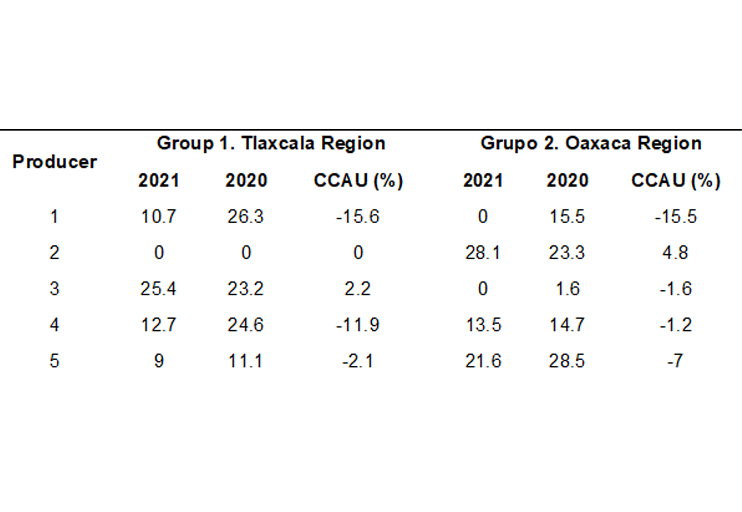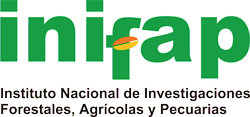Economic impact of the use of agroecological innovations by small corn farmers in Tlaxcala and Oaxaca
DOI:
https://doi.org/10.29312/remexca.v16i2.3408Keywords:
bioinputs, corn, peasant agricultureAbstract
The agroecological transition of agricultural production is a medium-term process, so estimating the effect of using agroecological innovations through economic indicators can contribute to the identification of areas of opportunity and decision-making within the framework of this new paradigm. The objective was to estimate the economic effect of the use of agroecological innovations by small rainfed corn producers in Tlaxcala and Oaxaca, through economic indicators, during 2020 and 2021. The sample was non-probabilistic and aimed at 10 corn producers: five producers from Tlaxcala (G1) and five producers from Oaxaca (G2). The results showed that the groups are similar in their social and productive characteristics, they only differed (p< 0.05) in agricultural area. Three indicators that measure the economic effect of the use of technologies were obtained: change in production cost (CPC), change in yield (CY), and change in the cost of agrochemical use (CCAU). The CPC ranged from -3.1 to 14.6% for G1 and from -4.6 to 27.7% for G2; the CY was 12.8 and 6.8% for G1 and G2, respectively, and the CCAU from -15.6 to 2.2% for G1 and from -15.5 to 4.8% for G2. Obtaining the indicators can make it possible to identify producers with more sustainable food systems, analyze their components, and generate recommendations for replicating these systems.
Downloads
References
Abascal, F. E. y Grande, E. I. 2005. Análisis de encuestas. Edit. ESIC. España. 292 p.
Aguilar, G. N.; Muñoz, R. M.; Santoyo-Cortés, V. H. y Aguilar, A. J. 2013. Influencia del perfil de los productores en la adopción de innovaciones en tres cultivos tropicales. Teuken Bidikay. 4(4):207-228.
Alean, C. I. 2004. Patogenicidad de diferentes hongos entomopatógenos para el control de Aleurotrachelus Socialis (Homoptera: aleyrodidae) bajo condiciones de invernadero. Revista Colombiana de Entomología. 30(1):29-36.
Altieri, M. A. y Nicholls, C. I. 2007. Conversión agroecológica de sistemas convencionales de producción: teoría, estrategias y evaluación. Ecosistemas. 16(1):3-12. https://www.revistaecosistemas.net/index.php/ecosistemas/article/view/133.
Altieri, M. A.; Funes-Monzote, F. R. and Petersen, P. F. 2012. Agroecologically efficient agricultural systems for smallholder farmers: contributions to food sovereignty. Agronomy for Sustainable Development. 32(1):1-13. doi.org/10.1007/s13593-011-0065-6.
Bathaei, A. and Štreimikienė, D. 2023. A systematic review of agricultural sustainability indicators. Agriculture. 13(2):241. https://doi.org/10.3390/agriculture13020241.
Bonaudo, T.; Burlamaqui, B. A.; Sabatier, R.; Ryschawy, J.; Bellon, S.; Leger, F.; Magda, D. and Tichit, M. 2014. Agroecological principles for the redesign of integrated crop-livestock systems. European Journal of Agronomy. 57:43-51. https://doi.org/10.1016/j.eja.2013.09.010.
Caron, P.; Biénabe, E. and Hainzelin, E. 2014. Making transition towards ecological intensification of agriculture a reality: the gaps in and the role of scientific knowledge. Current Opinion in Environmental Sustainability. 8:44-52. https://doi.org/10.1016/j.cosust.2014.08.004.
Carrillo-Saucedo, S. M.; Puente-Rivera, J.; Montes-Recinas, S. y Cruz-Ortega, R. 2022. Las micorrizas como una herramienta para la restauración ecológica. Acta Botánica Mexicana. 129:1-27. Doi: org/10.21829/abm129.2022.1932.
Cevallos, S. M.; Urdaneta, O. F. y Jaimes, E. 2019. Desarrollo de sistemas de producción agroecológica: Dimensiones e indicadores para su estudio. Revista de Ciencias Sociales. 25(3):172-185.
DOF. 2023. Diario Oficial de la Federación. Acuerdo por el que se dan a conocer las reglas de operación del programa producción para el bienestar. Secretaría de Agricultura y Desarrollo Rural para el ejercicio fiscal 2024. https://dof.gob.mx/nota-detalle.php?codigo=5713354&fecha=29/12/2023#gsc.tab=0.
Donnet, M. L.; López-Becerril, I. D.; Black, J. R. and Hellin, J. 2017. Productivity differences and food security: a Meta frontier analysis of rain-fed maize farmers in MasAgro in Mexico. AIMS Agriculture and Food. 2(2):129-148. Doi: 10.3934/agrfood.2017.2.129.
Duke, S. O. 2018. Pest management science 2017. Pest Management Science. 74(1):7-8.
Gutiérrez, C. J. G.; Aguilera, G. L. I. y González, E. C. E. 2008. Agroecología y sustentabilidad. Convergencia. 46(1):51-87.
Heckwolf, M. J.; Peterson, A.; Jänes, H.; Horne, P.; Künne, J.; Liversage, K.; Sajeva, M.; Reusch, T. B. H. and Kotta, J. 2021. From ecosystems to socio-economic benefits: a systematic review of coastal ecosystem services in the Baltic Sea. Science of the total environment. 755:1-11. https://doi.org/10.1016/j.scitotenv.2020.142565.
Herrmann, L. and Lesueur, D. 2013. Challenges of formulation and quality of biofertilizers for successful inoculation. Applied Microbiology and Biotechnology. 97(20):8859-8873.
INEGI. 2016. Instituto Nacional de Estadística y Geografía. Anuario estadístico y geográfico de Oaxaca. 26-38 pp. https://www.inegi.org.mx/contenidos/productos/prod-serv/contenidos/espanol/bvinegi/productos/nueva-estruc/anuarios-2016/702825084295.pdf.
INEGI. 2018. Instituto Nacional de Estadística y Geografía. Aspectos geográficos. Tlaxcala. 29 p. https://inegi.org.mx/contenidos/app/areasgeograficas/resumen/resumen.
INEGI. 2023. Instituto Nacional de Estadística y Geografía. https://www.inegi.org.mx/app/indicesdeprecios/Estructura.aspx?idEstructura=1120015000300040&ST=%C3%8Dndices%20de%20precios%20de%20gen%C3%A9ricos%20para%20mercado%20nacional.
Lazos, C. E. 2014. Consideraciones socioeconómicas y culturales en la controvertida introducción del maíz transgénico: caso de Tlaxcala. Sociológica. 29(83):201-240.
López-Escudero, R. J.; López-Romero, G.; Lango-Reynoso, V. y Inurreta-Aguirre, H. D. 2023. Análisis de fertilización en el agroecosistema maíz en la cuenca de Papaloapan. Revista Mexicana de Ciencias Agrícolas. 14(8):e3378. https://doi.org/10.29312/remexca.v14i8.3378.
López, R. M. C. y Villa, A. J. 2021. Estrategia para el manejo agroecológico del gusano cogollero. Centro Internacional de Mejoramiento de Maíz y Trigo. https://idp.cimmyt.org/estrategia-para-el-manejo-agroecologico-del-gusano-cogollero/.
Minitab, L. L. C. 2021. Minitab: statistical software. Pennsylvania State University, USA. https://www.minitab.com/en-us/.
Morales-Ruiz, A. y Díaz-López, E. 2020. Influencia de la temperatura, precipitación y radiación solar en el rendimiento de maíz en el valle de Toluca, México. Agrociencia. 54(3):377-385. https://doi.org/10.47163/agrociencia.v54i3.1933.
Porras, J. C. 2016. Comparación de pruebas de normalidad multivariada. Anales Científicos. 77(2):141-146. https:// doi.org/10.21704/ac.v77i2.483.
Silva-Cassani, N.; Mancera, K. F.; Canul, J.; Ramirez Aviles, L.; Solorio, J.; Güereca, P. and Galindo, F. 2022. Evaluation of the sustainable performance of native and intensive silvopastoral systems in the Mexican tropics using the MESMIS framework. Tropical and Subtropical Agroecosystems. 25(3):1-22. Doi: http://dx.doi.org/10.56369/tsaes.3556.
Tittonell, P. 2019. Las transiciones agroecológicas: múltiples escalas, niveles y desafíos. Revista de la Facultad de Ciencias Agrarias. 51(1):231-246.
Teixeira, H. M.; Schulte, R. P. O.; Anten, N. P. R.; Bosco, C. L.; Baartman, J. E. M.; Moinet, G. Y. K. and Reidsma, P. 2022. How to quantify the impacts of diversification on sustainability? A review of indicators in coffee systems. Agronomy for Sustainable Development. 42(62):1-26. https://doi.org/10.1007/s13593-022-00785-5.

Published
How to Cite
Issue
Section
License
Copyright (c) 2025 Revista Mexicana de Ciencias Agrícolas

This work is licensed under a Creative Commons Attribution-NonCommercial 4.0 International License.
The authors who publish in Revista Mexicana de Ciencias Agrícolas accept the following conditions:
In accordance with copyright laws, Revista Mexicana de Ciencias Agrícolas recognizes and respects the authors’ moral right and ownership of property rights which will be transferred to the journal for dissemination in open access. Invariably, all the authors have to sign a letter of transfer of property rights and of originality of the article to Instituto Nacional de Investigaciones Forestales, Agrícolas y Pecuarias (INIFAP) [National Institute of Forestry, Agricultural and Livestock Research]. The author(s) must pay a fee for the reception of articles before proceeding to editorial review.
All the texts published by Revista Mexicana de Ciencias Agrícolas —with no exception— are distributed under a Creative Commons License Attribution-NonCommercial 4.0 International (CC BY-NC 4.0), which allows third parties to use the publication as long as the work’s authorship and its first publication in this journal are mentioned.
The author(s) can enter into independent and additional contractual agreements for the nonexclusive distribution of the version of the article published in Revista Mexicana de Ciencias Agrícolas (for example include it into an institutional repository or publish it in a book) as long as it is clearly and explicitly indicated that the work was published for the first time in Revista Mexicana de Ciencias Agrícolas.
For all the above, the authors shall send the Letter-transfer of Property Rights for the first publication duly filled in and signed by the author(s). This form must be sent as a PDF file to: revista_atm@yahoo.com.mx; cienciasagricola@inifap.gob.mx; remexca2017@gmail.
This work is licensed under a Creative Commons Attribution-Noncommercial 4.0 International license.


